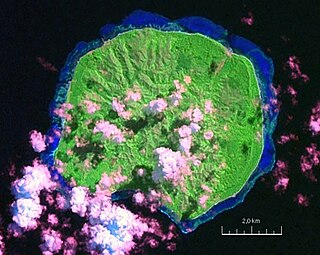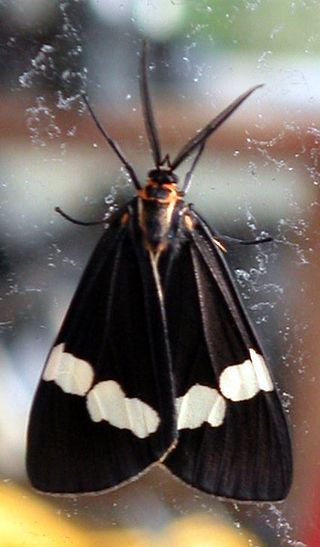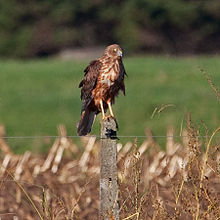
The Australian magpie is a black and white passerine bird native to Australia and southern New Guinea, and introduced to New Zealand. Although once considered to be three separate species, it is now considered to be one, with nine recognised subspecies. A member of the Artamidae, the Australian magpie is placed in its own genus Gymnorhina and is most closely related to the black butcherbird. It is not closely related to the European magpie, which is a corvid.

Abel Tasman National Park is a New Zealand national park located between Golden Bay / Mohua and Tasman Bay at the north end of the South Island. It is named after Abel Tasman, who in 1642 became the first European explorer to sight New Zealand and who anchored nearby in Golden Bay.

The New Zealand kākā is a large species of parrot of the family Nestoridae found in New Zealand's native forests. The species is often known by the abbreviated name kākā, although it shares this name with the recently extinct Norfolk kākā and Chatham kākā. Two subspecies of New Zealand kākā are recognised. It is endangered and has disappeared from much of its former range, though the re-introduction of North Island kākā at Zealandia in Wellington has led to an increasing population of the birds across the city.

A number of introduced species, some of which have become invasive species, have been added to New Zealand's native flora and fauna. Both deliberate and accidental introductions have been made from the time of the first human settlement, with several waves of Polynesian people at some time before the year 1300, followed by Europeans after 1769.

Conservation in New Zealand has a history associated with both Māori and Europeans. Both groups of people caused a loss of species and both altered their behaviour to a degree after realising their effect on indigenous flora and fauna.

There are a number of Australian species that have become invasive when introduced into outside Australia or outside Oceania.

Cicia is a Fijian island of the Lau Group. One of the Northern Lau Islands, Cicia is volcanic and is composed of raised coral. Its area is 34.6 square kilometres (13 sq mi).

The badge on the Flag of South Australia depicts the rising sun, and a Piping Shrike standing on a branch of a gum tree. The Piping Shrike is more commonly known as a White-backed Magpie.

The black-fronted tern, also known as sea martin, ploughboy, inland tern, riverbed tern or tarapiroe, is a small tern generally found in or near bodies of fresh water in New Zealand, where it forages for freshwater fish, arthropods and worms. It has a predominantly grey plumage. Restricted to breeding in the eastern regions of the South Island, it is declining and threatened by introduced mammals and birds. It is rated as endangered on the International Union for Conservation of Nature (IUCN)'s Red List of Threatened Species.
Acclimatisation societies were voluntary associations, founded in the 19th and 20th centuries, that encouraged the introduction of non-native species in various places around the world, in the hope that they would acclimatise and adapt to their new environments. The societies formed during the colonial era, when Europeans began to settle in numbers in unfamiliar locations. One motivation for the activities of the acclimatisation societies was that introducing new species of plants and animals would enrich the flora and fauna of target regions. The movement also sought to establish plants and animals that were familiar to Europeans, while also bringing exotic and useful foreign plants and animals to centres of European settlement.

The common brushtail possum was introduced from Australia to New Zealand, where it has become invasive and a major agricultural and conservation pest.

Acclimatisation societies to naturalise all kinds of new species —as long as they had no harmful effect— were established in New Zealand by European colonists from the 1860s, with the first likely having been established in Auckland around 1861.

Nyctemera annulata, the magpie moth, is a moth of the family Erebidae. The species was first described by Jean Baptiste Boisduval in 1832. It is endemic to New Zealand and found in all parts of the country.

The European hedgehog was brought to New Zealand by British colonists in the 1870s to remind them of their homeland. They have spread throughout the country, being absent only in inhospitable environments. The general public has a benign attitude to them but conservationists and regional councils regard them as pests, as they prey on native animals and compete with them for food.

Artamidae is a family of passerine birds found in Australia, the Indo-Pacific region, and Southern Asia. It includes 24 extant species in six genera and three subfamilies: Peltopsinae, Artaminae and Cracticinae. Artamids used to be monotypic, containing only the woodswallows, but it was expanded to include the family Cracticidae in 1994. Some authors, however, still treat the two as separate families. Some species in this family are known for their beautiful song. Their feeding habits vary from nectar sucking (woodswallows) to predation on small birds.

Phaulacridium marginale is a small species of short-horned grasshopper in the family Acrididae. It is endemic to New Zealand where it is found in low elevation open habitat throughout North Island, South Island, Stewart Island and on many smaller islands.

New Zealand is geographically isolated, and originally lacked any mammalian predators, hence parrots evolved to fill habitats from the ground dwelling kākāpō to the alpine dwelling kea as well as a variety of forest species. The arrival of Māori, then European settlers with their attendant animals, habitat destruction and even deliberate targeting, has resulted in their numbers plummeting. Today one species is on the brink of extinction and three other species range from Vulnerable to Critically Endangered, all impacted by invasive species. Further parrot species were not introduced by acclimatisation societies, but occasional releases, both deliberate and accidental, have resulted in self-sustaining populations of some Australian species. New Zealand was identified among the highest priority countries for parrot conservation in the world, due to its parrot diversity, endemism, threats, and having more threatened parrot species than expected.

Cats are a popular pet in New Zealand. Cat ownership is occasionally raised as a controversial conservation issue due to the predation of endangered species, such as birds and lizards, by feral cats.
The NEXT Foundation is a privately funded New Zealand strategic philanthropy foundation launched in March 2014. It has a mandate to spend down $100 million over 10 years into environmental and educational projects that will benefit future generations of New Zealanders. NEXT Foundation invests in a small number of multi year initiatives with both financial and non financial support. It targets initiatives that are transformational, inspirational and run in a business like way.
Gisela Kaplan is an Australian ethologist who primarily specialises in ornithology and primatology. She is a professor emeritus in animal behaviour at the University of New England, Australia, and also honorary professor of the Queensland Brain Institute.


















